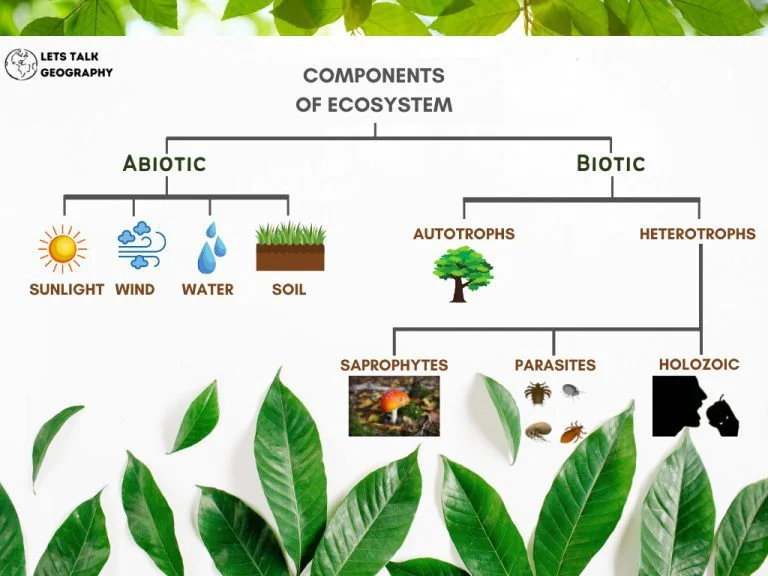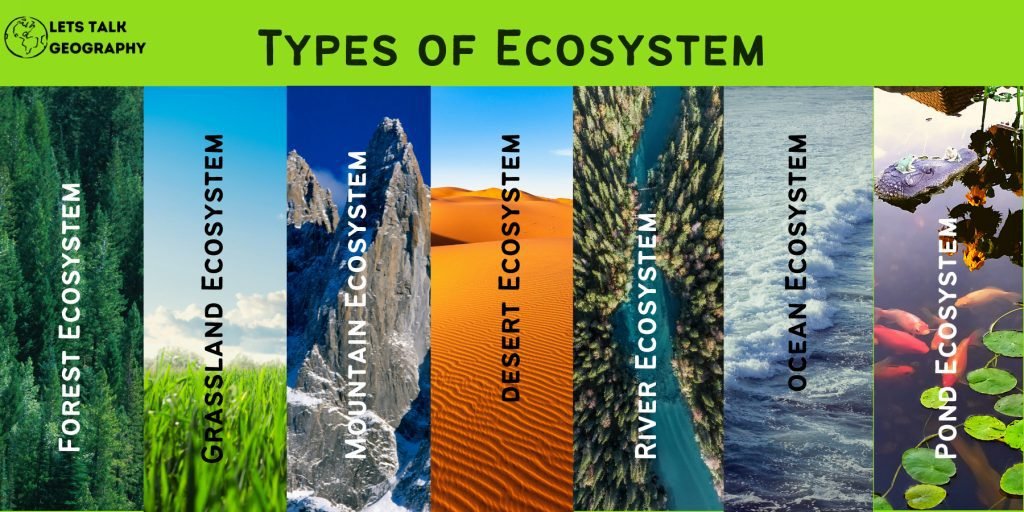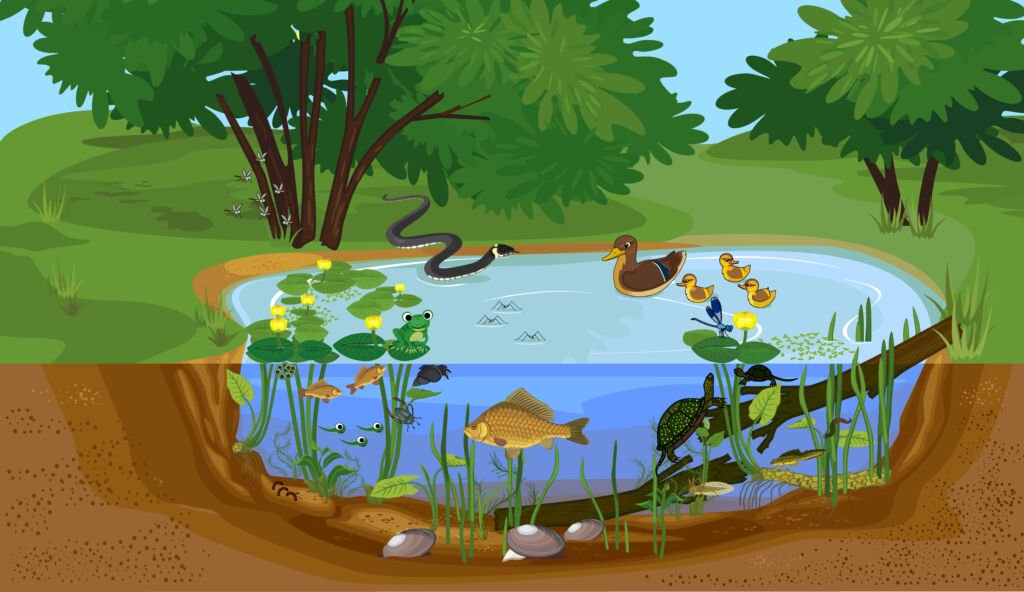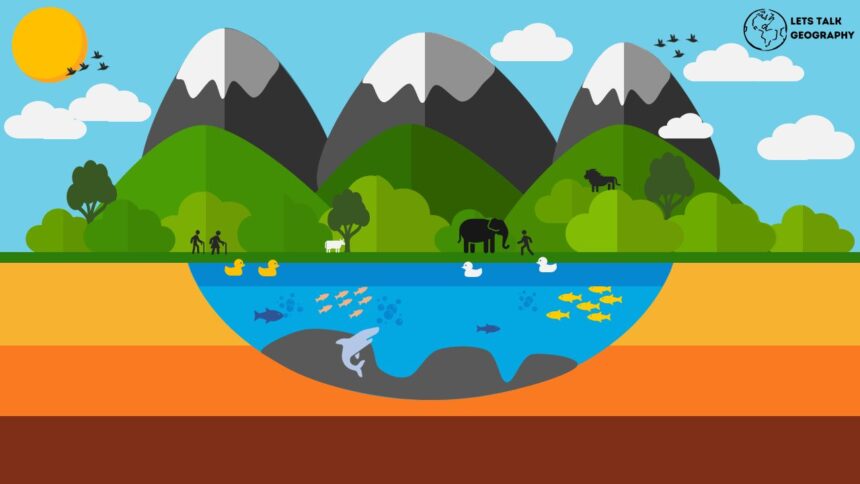What is Ecosystem?
A.G. Tansley in 1935, first coined the term ecosystem. According to him, it is “a particular category of physical systems consisting of organisms and inorganic components in a relatively stable equilibrium, open and various sizes, and kinds”.
In other words, the ecosystem may be defined as ‘the interrelationship between the living and the non-living components of the environment. All the abiotic and the biotic components are interrelated with each other through different biogeochemical cycles.
Thus, it is the structural as well as the functional unit of the ecology. It is the smallest unit of the biome. The natural environment in which a particular plant or animal species lives in an ecosystem is termed a habitat. So, habitat is an important part of an ecosystem.
What are the Characteristics of Ecosystem?
In every part of the world, different types of ecosystems are identified. All these have their own uniqueness. All of them have a few similarities in functioning, stability, importance, and destruction. The common characteristics are as follows:
- These are the representation of the sum of all living organisms and the physical environment.
- The basic components are – energy, biome and habitat.
- It has a spatial dimension.
- These are studied in terms of the temporal dimension.
- It expresses complex interrelationships among the components.
- It is an open system of matter and energy.
- It is relatively stable.
- It is powered by energy, predominantly, solar energy.
- It is a functional unit.
- It is productive
- It has a scale dimension as it varies spatially.
- It is sequentially developed.
What are the Components of Ecosystem?
Every ecosystem is made up of two types of components – abiotic or non-living components and biotic or living components. Sunlight, air, water, soil etc. all are inorganic or abiotic components. Sunlight or solar energy is the main driving agent of all ecosystems.

The biotic components include all plants, animals, and micro-organisms. These organic components can broadly be divided into –
- Autotrophs (green plants that can produce food of their own by the processes of photosynthesis and chemosynthesis)
- Heterotrophs (consumers who depend on autotrophs for food)
The Autotrophs are further divided into –
- Phototrophs (producers which prepare food through photosynthesis using solar energy)
- Chemotrophs (which prepare food through chemosynthesis using atmospheric oxygen)
The heterotrophs are also subdivided into –
- Saprophytes (depending on dead plants and animals for nutrition)
- Parasites (depending on living organisms for nutrition)
- Holozoic (consumers who get food through the mouth)
In general, all the components are classified into four broad categories based on function –
- Abiotic elements, including abiotic components and dead biotic compounds.
- Producers
- Consumers, including herbivores, carnivores and omnivores
- Decomposers
So, we can clearly say that no ecosystem can exist without either producers or consumers. It is how it’s formed and it’s the inter-relationship of these two components how it works. It can not survive without any one of it.
Types of Ecosystem
The biotic and abiotic factors and the prevalent biodiversity make the ecosystem unique and are also influenced by the habitat. On so many bases it can be classified as
A. Based on habitat
Terrestrial ecosystem:
- Forest ecosystem
- Grassland ecosystem
- Desert ecosystems, including hot desert and cold desert
Aquatic ecosystem:
Freshwater ecosystem-
- River ecosystem
- Lacustrine ecosystem
- Pond ecosystem
- Marsh ecosystem
- Marine ecosystem-
- Estuaries ecosystem
- Open ocean ecosystem
- Ocean surface ecosystem
- Ocean bottom ecosystem

B. On the basis of stages of development.
- Early succession ecosystem
- Mature ecosystem
- Mixed ecosystem
- Inert ecosystem
C. On the basis of spatial scale-
- Continental ecosystem
- Marine ecosystem
D. On the basis of stability-
- Simple stable ecosystem
- Complex unstable ecosystem
E. On the basis of uses –
- Natural ecosystem
- Cultivated ecosystem
How does the ecosystem function?

The pattern of the energy flow controls the functionality of the ecosystem. The energy flow follows a unidirectional pattern. The First and the Second Laws of Thermodynamics govern the energy flow pattern.
Solar energy is the basic input in the energy cycle of the ecosystem. Solar energy is stored in the food as chemical energy in the form of carbohydrates through the process of photosynthesis carried out by the green plants, i.e., the autotrophs.
Most of the energy received is lost from the ecosystem following the ‘Lindeman’ 10% Loss‘ principle. Only a small share of energy is used by the green plants, i.e., the producers.
All the heterotrophs depend on the autotrophs for food as they are unable to complete photosynthesis. All the heterotrophs, i.e., the consumers (herbivores, carnivores, omnivores) depend on the chlorophyll-rich plants.
These networks of dependencies create the energy flow of the ecosystem and strengthen its functionality.
The biotic components are interlinked with each other as well. These interlinks are attained through different trophic levels. Energy flows from the Trophic Level I to Trophic Level III. Finally, the biotic components die and are decomposed by the microorganisms i.e., the decomposes.
The organic and the inorganic substances move in reverse in various closed cyclic paths among the biosphere, atmosphere, hydrosphere and lithosphere. In this way, the nutrients pass into different biotic communities through the biogeochemical cycles driven by the energy cycle. Hence, the soluble nutrients are circulated in the ecosystem.
What is Ecosystem Productivity?
The productivity of the ecosystem is the rate of growth of energy or organic substance per unit of time by the producers at the Trophic Level I through the process of photosynthesis including solar energy.
This productivity depends on two factors – (a) the amount of solar energy available to the producers at Trophic Level I, and (b) the efficiency of the green plants to convert solar energy into chemical energy. It is measured in gram/m2/year or day.
What is Ecosystem Stability?
The balance between the production and consumption of elements in the ecosystem is termed the stability of the ecosystem. A normal ecosystem maintains an equilibrium condition, i.e., a homeostatic mechanism. It is the inbuilt self-regulating mechanism of an ecosystem that helps it to counterbalance any change that occurred in it and restore stability.
Importance of Ecosystem Stability:
1. Sustainability of Resources
- Provision of Ecosystem Services: Stable ecosystems consistently provide vital services like clean water, air purification, fertile soil, pollination, climate regulation, and food production. These services are essential for human well-being and support our economies.
- Resilience to Change: A stable ecosystem is better equipped to handle disturbances like natural disasters, pollution, or climate change. This resilience means resources are more likely to remain available even in the face of challenges.
2. Biodiversity and Healthy Populations
- Support for Diverse Life: Stable ecosystems maintain a rich variety of plants, animals, and microorganisms (biodiversity), which is crucial for overall ecological health.
- Balanced Populations: Stability helps keep population sizes of different species in check, preventing any one species from becoming too dominant or disappearing altogether. This balance is essential for maintaining a functioning food web.
3. Resistance to Negative Impacts
- Control of Pests and Diseases: Balanced, stable systems tend to have natural control mechanisms for invasive species, pests, and disease outbreaks. This reduces the need for human intervention like pesticides.
- Reduced Damage: A stable ecosystem is less prone to catastrophic events like uncontrolled wildfires, drastic algae blooms, or soil erosion.
4. Human Well-being
- Economic Benefits: Stable ecosystems support industries like agriculture, fishing, forestry, and tourism. They provide raw materials and contribute to a healthy economy.
- Social and Cultural Value: Many cultures have strong connections to specific ecosystems for spiritual, recreational, and traditional purposes. Ecosystem stability helps preserve these values.
- Health Benefits: Clean air, water, and access to nature provided by stable ecosystems are vital for physical and mental health.
How is the Ecosystem destroyed?
When the homeostatic mechanism is affected and fails to adjust and restore stability, it is referred to as ecosystem instability. Numerous anthropogenic factors cause this instability. All these instabilities destroy the ecosystem. Mostly human interferences are the major reasons behind the destruction.
1. Habitat Destruction
- Deforestation: Cutting down forests for timber, agriculture, or urbanization removes vital habitat and disrupts entire food webs.
- Land Conversion: Converting natural areas like grasslands or wetlands for development or agriculture destroys unique ecosystems and their species.
- Infrastructure Development: Building roads, dams, and cities fragments habitats, making it difficult for species to move and access resources.
2. Overexploitation of Resources
- Overhunting and Overfishing: Taking too many animals from a population for food or trade can lead to their decline or even extinction, disrupting the balance of the food chain.
- Unsustainable Resource Extraction: Excessive harvesting of timber, minerals, or other natural resources degrades ecosystems and depletes essential components.
3. Pollution
- Chemical Pollution: Release of industrial waste, agricultural runoff containing pesticides and fertilizers, and even household chemicals into waterways and the soil can poison organisms, alter food webs, and degrade habitats.
- Air Pollution: Emissions from vehicles and factories contribute to acid rain, smog, and climate change, which can damage plants, disrupt ecosystems on a larger scale, and harm wildlife.
- Plastic and Waste Pollution: Trash, especially plastics, chokes waterways, entangles and kills wildlife, and breaks down into microplastics that infiltrate food chains.
4. Introduction of Invasive Species
- Non-native Predators and Competitors: When species are brought to a new area intentionally or accidentally, they can outcompete native species for resources, prey on them with no natural controls, or introduce disease, leading to ecosystem collapse.
5. Climate Change
- Temperature Changes: Global warming shifts the ranges of suitable habitat for many species, forcing them to move or perish, and disrupting established interactions within ecosystems.
- Extreme Weather Events: Increased frequency and intensity of droughts, floods, storms, and wildfires cause widespread destruction of habitats and displacement of wildlife.
- Ocean Acidification: Rising carbon dioxide levels change the chemistry of seawater, harming coral reefs, shellfish, and other marine organisms foundational to ocean food chains.
Ecosystem destruction often has delayed and cascading effects, making it hard to fully grasp the consequences or reverse the damage. These causes don’t work in isolation. Climate change amplifies existing threats, habitat loss increases species’ vulnerability to pollution, and so on.
⫸ Conservation of Ecosystems:
Combining multiple strategies is often most effective. The best methods depend on the type of ecosystem (forest, ocean, grassland, etc.) and its unique needs. Collaboration between governments, landowners, indigenous communities, and scientists is crucial for impactful conservation.
1. Creation of Protected Areas
- National Parks and Wildlife Sanctuaries: Large designated areas with legal protections to restrict activities that harm wildlife and habitats. These provide vital refuges for vulnerable species.
- Marine Protected Areas: Similar to national parks, but dedicated to conserving ocean and freshwater ecosystems.
- Community-Managed Conservation Areas: Efforts led by local communities to protect and sustainably use their natural resources.
2. Landscape-Level Management
- Habitat Restoration: Restoring degraded lands, replanting forests, cleaning up polluted areas, etc. This is done to bring ecosystems back to healthier states.
- Ecological Corridors: Connecting fragmented habitats allows wildlife migration and gene flow, supporting populations and increasing resilience.
- Sustainable Practices: Promoting sustainable agriculture, responsible forestry, and fishing techniques that minimize negative impacts on ecosystems.
3. Species-Specific Conservation
- Captive Breeding: Breeding endangered species in protected environments to increase their numbers and potentially reintroduce them to the wild.
- Targeted Conservation Planning: Protecting keystone species (those with a disproportionately large role in the ecosystem) or focusing on particularly threatened hotspots of biodiversity.
- Combating Threats: Addressing poaching, invasive species, and pollution that directly harm species.
4. Policy and Legislation
- Environmental Laws: Strong regulations protecting air and water quality, preventing habitat destruction, and regulating industries that impact ecosystems.
- Wildlife Trade Restrictions: Bans on illegal wildlife products (ivory, rhino horn) to combat poaching and protect endangered species.
- Economic Incentives: Providing financial support for conservation work, ecotourism, and sustainable practices that benefit both ecosystems and people.
5. Education and Awareness
- Public Outreach: Educating people about the value of ecosystems, the threats they face, and actions individuals can take to help.
- Community Engagement: Local communities taking ownership of conservation projects, leading to more effective and lasting results.
- Citizen Science: Encouraging people to participate in data collection and monitoring, contributing to conservation efforts.
⫸ Conclusion:
In conclusion, an ecosystem is a community of different species that interact with one another and their environment to produce the desired effect. The characteristics of an ecosystem are its size, boundaries, diversity, complexity, and stability. The components of an ecosystem include producers, consumers, decomposers, abiotic factors, and biotic factors. There are three types of ecosystems: terrestrial (on land), aquatic (in water), and aerial (in the air). Ecosystems function through the cycling of matter and energy.
By understanding these principles about ecosystems, we can better manage them for human benefit. We hope you’ve enjoyed learning about ecosystems!
As always, we love to hear your thoughts. What did you find most interesting? Do you believe that humans should try to preserve or restore damaged ecosystems? Are there any types of ecosystems we missed that you would like us to cover in a future post? Let us know in the comments below!
⫸ Frequently Asked Questions on Ecosystem:
Q. What is an ecosystem?
A: An ecosystem refers to a group of living and non-living things that interact with one another to maintain the balance of their environment. The term ecosystem can be used to describe everything from a rainforest to a single pond.
Q. What are the different components of an ecosystem?
A: There are three main types of components in an ecosystem: biotic, abiotic, and detrital. Biotic components are living things, abiotic components are non-living things, and detrital components are dead or decaying organic matter.
Q. What is the importance of ecosystem stability?
A: The stability of an ecosystem is important because it ensures that the balance of the environment is maintained. If one component of an ecosystem is removed or changed, it can upset the balance and have a ripple effect on the rest of the ecosystem.
Q. What causes an ecosystem to become unstable?
A: Several factors can cause an ecosystem to become unstable, including pollution, deforestation, overfishing, and climate change.
Q. What are some ways to help protect and preserve ecosystem stability?
A: There are several ways to help protect and preserve ecosystem stability, including reducing pollution, restoring degraded ecosystems, and promoting sustainable agriculture.
Q. What is Early Succession?
A: Early succession refers to the initial stages of ecological development following a disturbance that significantly alters or wipes out an area’s existing plant and animal community. Early successional ecosystems are temporary communities paving the way for later, more stable stages. Disturbances can be natural (fires, floods, volcanic eruptions) or human-caused (deforestation, agriculture, land clearing).






Remarkable! Its in fact amazing post, I have got much clear idea about from this piece of writing.
We’re a bunch of volunteers and starting a new scheme in our community. Your website offered us with valuable information to work on. You have done a formidable process and our entire neighborhood can be thankful to you.